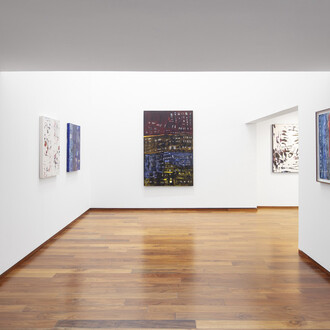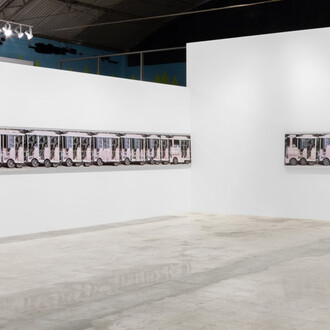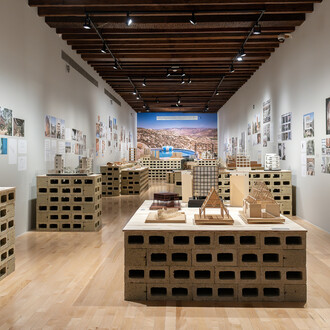In the 1960s, the edges of Mexico City were mapped out on the basis of the main thoroughfares, which were continuously built to keep up with the transportation needs of an ever-developing population. This happened specifically with the Anillo Periférico (Ring Road), the laying of which initially involved marking out a territory, even as it subsequently contributed to the expansion of the city itself. At the time, the architects and artists who were part of the cultural ecosystem championed the visual and spatial modification of the megalopolis based on their pictorial, sculptural, and architectural projects. That was the context in which the output of the Mexican sculptors Ángela Gurría (1929–2023) and Helen Escobedo (1934–2010) was inscribed, as they developed their work in such disciplines as drawing, painting, and small- and medium-format sculpture. Nevertheless, the work of these two artists was renowned more for the way it unfolded in the creation of monumental and public sculpture in Mexico. One can identify in their work an abiding interest in the effects of the city’s exorbitant growth, like overpopulation and the increase in motor vehicles as well as air, noise, and visual pollution.
In the late 1960s, sculptors started emphasizing spatiality over visual language1, which was very relevant a decade earlier with the inclusion of visual artists in the creation of University City in southern Mexico City. Ángela Gurría’s and Helen Escobedo’s production took place in the wake of the debate about geometrical abstraction in opposition to the figuration and social realism2 upheld by the artists of the Mexican School of Painting. In this way, abstraction, materiality, and space gained steam in sculptural production, pushing aside representation, figuration, and themes with a historical bent. As artists, Gurría and Escobedo penetrated a sculptural world that was regarded as masculine, due primarily to the use of heavy, inflexible materials, along with the use of tools that required a certain degree of physical strength3. Both sculptors overcame certain boundaries by persevering in their sculptural practice.
Their work converged in 1968, the year when the 19th Olympic Games were held in Mexico City. For this event, the painter and sculptor Mathias Goeritz proposed to the architect Pedro Ramírez Vázquez, president of the Organizing Committee for that edition of the Olympic Games, to carry out an international meeting of sculptors as part of a Cultural Olympics, with the objective of creating a sculpture project that would include monumental concrete sculptures4. The team from the Mexican delegation consisted of Ángela Gurría, Helen Escobedo, and Jorge Dubón, who participated in the project, subsequently named the Ruta de la Amistad(Route of Friendship), and which was consummated with the building of 18 monumental sculptures located strategically around the circumference of the Anillo Periférico. For this project, Escobedo made Puertas al viento (Doors to the wind), a 17-meter-tall sculpture painted in green and blue stripes that alluded to the sky and the fields of alfalfa that were still part of cityscape in the area around Cuemanco5. For her part, Gurría presented Señales (Signals) in the San Jerónimo roundabout; years later, it was moved to the intersection of the Anillo Periférico and Avenida Insurgentes.
Conceiving the sculptural, inhabiting the public: Ángela Gurría and Helen Escobedo shows work these artists made starting in the 1970s, a period when their work flourished following their participation in the Ruta de la amistad. The pieces presented are a sample of their explorations of materiality and spatiality. In Gurría’s case, we see works made with a variety of materials, including sterling silver, forged iron, sheet iron, quarry stone, and concrete, as well as works done with pencil, watercolor, and pastel on paper. Around this time, we see the beginning of an outline of her interest in materiality by allowing this to play the leading role over form, as well as the formation of more specific ideas about the social function of sculpture, its integration into everyday life, and its relationship to the collective.
The show also includes models of works that were later developed into monumental projects. Such is the case of Model for Río Papaloapan (1970), the public sculpture currently found outside the Museo de Arte Moderno in Mexico City, and Model for México Monumento al mestizaje (1973–1974), with its monumental counterpart now located on the Paseo de los Héroes, at the corner of Boulevard Independencia, in Tijuana, Baja California. The same goes for Model for the Monumento a los trabajadores del drenaje profundo (1974), made with plaster and metal, the monumental version of which was part of Mexico City’s now defunct Museo del Drenaje.
Gurría’s work has superficially been identified by her interest in representing the natural world and by her connection with materials, marking rhythm and sound while working with stone and rock. In her work there is a relationship between the body and matter, but above all a link with nature6. Art historian Daniel Garza Usabiaga stresses that Gurría went beyond the debate around abstraction through her humanistic interests, such that her pieces can be understood through a symbolic language of nature. We see this in the pieces Mariposa (Butterfly, ca. 1970), Celosía de mariposas (Butterfly lattice, 1966), in her models of the Papaloapan (1970) and Grijalva (1974) Rivers, arco iris (Rainbow, 1978), and in the models for the Monarch Butterfly, which combine symbolism with geometry to represent animals and natural features. Her vision extended beyond an ecological consciousness, for in her work there was an inclination to return to nature. She also worked on the duality of life and death and other motifs inspired by the imaginary of different pre-Hispanic cultures, especially in dialogue with the Mexica worldview. In 1984, the sculptor made her work Corazón mágico de Cutzamala—Homenaje a Tláloc (Magic heart of Cutzamala—Homage to Tlaloc), a monument dedicated to the Sistema Cutzamala, the waterworks that supplies Mexico City. With this project, the artist decided to pay homage to water by making a pyramidal construction fitted with blinders7, a distinctive accoutrement worn by Tlaloc, the Mexica god of rain, thunder, and water.
Helen Escobedo’s work focused on the relationship between art and the city, between the sculptural and the visual, making use of natural and industrial materials like lacquered aluminum and wood to make models, as well as work related to other disciplines like drawing in pencil, ink, and pastel on paper. Escobedo used these materials to make sketches in which she tried out her compositions and color selections for different sculptural projects. Some of her models, like Trilogía amarilla (Yellow trilogy), Señal amarilla (Díptico) (Yellow signal [Diptych], 1977), Elegía negra (Black elegy, 1979–2009) and Torres desfasadas (Towers out of phase, 1979–1980), were of sculpture projects that the artist conceived for different public spaces, including the Anillo Periférico, but were never realized on a monumental scale.
Escobedo’s creative process drew from other disciplines like drawing and photography. As art historian Rita Eder has noted, her studio work was multidisciplinary, since she used resources like photo-montage, collage, and models to design proposed sculptures for public space8; some of her pieces thus consist of diptychs that include a drawing or collage and a model made out of aluminum, metal, or plexiglass. These pieces make it possible to recognize part of Escobedo’s creative process, as in the cases of Desarrollo de un modulo / Puerta triple (Development of a module / Triple door, 1979–2009), Centinelas de Aztlán / Escaleras de caracol (azules) (Sentinels of Aztlán / [Blue] Snail shell stairs, 1981), and Propuestas urbanas: buscando escala / Escaleras de caracol (blancas) (Urban proposals: Looking for scale / [White] Snail shell stairs, ca. 1981). Several of these projects were never materialized on a monumental scale, but others, like Barda caída / Barda caída doble (Fallen fence / Double fallen fence, 1979) and De la ficción a la realidad: Coatl / Coatl (From fiction to reality: Coatl / Coatl, 1980–1982), were made in public space. The first of these led to the creation of La cerca caída (The fallen fence), completed in 1982 at the UNAM’s Facultad de Estudios Superiores de Iztacala during the celebration of the school’s 40th anniversary. The second became the monumental work titled Coatl, part of University City’s Sculpture Space, a collective project whose collaborators included Helen Escobedo herself, along with Manuel Felguérez, Mathias Goeritz, Federico Silva, and Hersúa y Sebastián, in a second phase of producing sculpture projects for the UNAM’s University City in Mexico City. Escobedo conceived Coatl as a sculpture comprising a succession of square frames that, arranged one after another, created a moving sculpture, painted with five colors representative of fire, that evokes a snake commonly found in the area of El Pedregal.
One of Escobedo’s primary interests was space, and that is obvious both in her works and her statements: “Space is the absolute mediator of everything, it’s what’s transparent and what’s defining [sic]… it’s mental and it’s physical… it has a destiny that predominates over the visual, plus the bodily and affective dimension of the observer, the visitor, inhabitant, or the public in general.”9 The sculptor thus thought of her pieces as integrative elements in space, conceiving them for the gaze of viewers in motion, a concept that David Alfaro Siqueiros had previously posited in his pictorial practice as a muralist. Escobedo intended to transform Mexico City, along with the environs of other parts of the country, integrating sculpture into the life of the city, into the street, into the nature that is born amongst the concrete, as well as conceiving the city as a stage on which architecture, urban design, and art can be seen to interpenetrate each other.
Conceiving the sculptural, inhabiting the public: Ángela Gurría and Helen Escobedo is an invitation to attend closely to these two sculptors’ ideas, concerns, and creative processes. At the same time, it opens the door to reflecting anew on public sculpture in Mexico, its insertion in space, the provocation that it elicits in the people who live here, but also to starting a dialogue about the notion of collective art and public art in the late twentieth century.
(Text by Vera Castillo)
Notes
1 Rita Eder, “Transformaciones y transgresiones: Dos o tres ideas sobre la obra de Helen Escobedo,” in Pasajes: Helen Escobedo, ed. Amalia Benavides, Irela Gonzaga, Magali Lara (UNAM, 2011), 11.
2 Daniel Garza Usabiaga, “Ángela Gurría: Segunda naturaleza,” in Ángela Gurría: Segunda naturaleza (Museo de Arte e Historia de Guanajuato, 2022), 19.
3 On this, Roselín Rodríguez Espinosa recuperates a comment of Rufino Tamayo’s about Ángela Gurría’s work published in the newspaper Excélsior in 1970, relative to an exhibition by the artist: “I’m surprised; Ángela Gurría’s exhibition strikes me as very surprising. I met her just a few days ago, and found the young woman enchanting, that fragility she has, it seems to me like it doesn’t correspond to the robustness of her work, but what is certain is that I’m surprised.” Roselín Rodríguez Espinosa, “A. de Ángela Gurría: La invención de un lugar para una mujer escultora de obras monumentales en el espacio público,” in Ángela Gurría: Señales (INBAL, 2024), 127.
4 Rita Eder, “La escultura contemporánea en México y la propuesta de Helen Escobedo,” in Helen Escobedo (UNAM, 1982), 40.
5 Helen Escobedo, “Aquí mismo, hace 31 años…,” in Pasajes, 82.
6 Daniel Garza Usabiaga, “Ángela Gurría: Segunda naturaleza,” 16.
7 Eunice Adorno and Sandra Rozental, “Revisitar los monumentos hidráulicos de Ángela Gurría,” in Ángela Gurría: Señales, 204.
8 Rita Eder, “Monumentos,” in Pasajes, 127.
9 Helen Escobedo, “El espacio es el mediador absoluto de todo,” in Pasajes, 41.
















